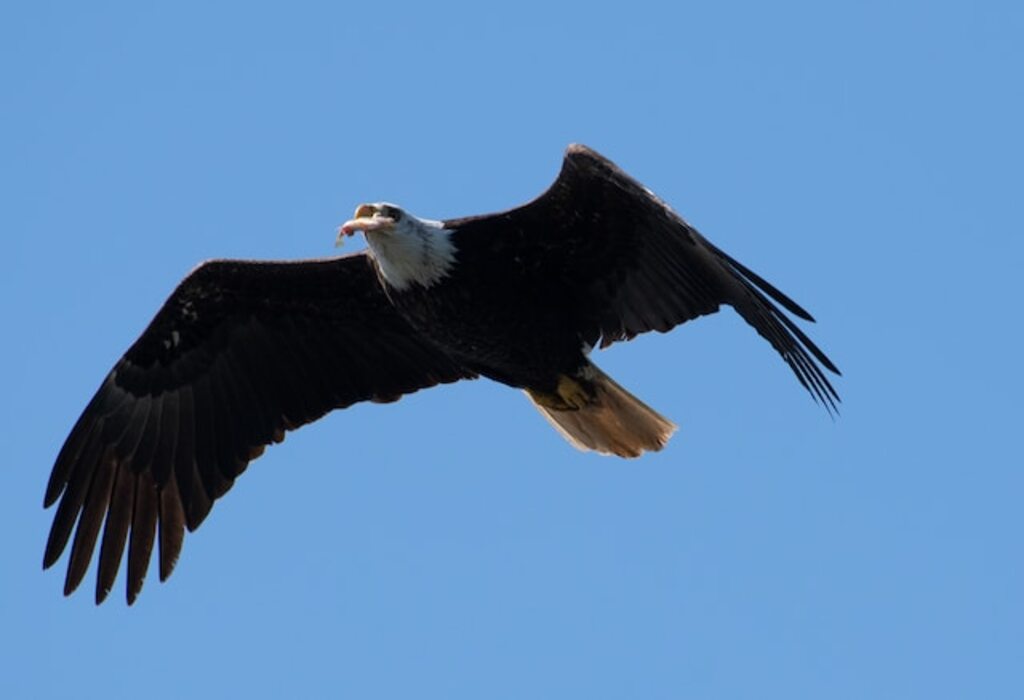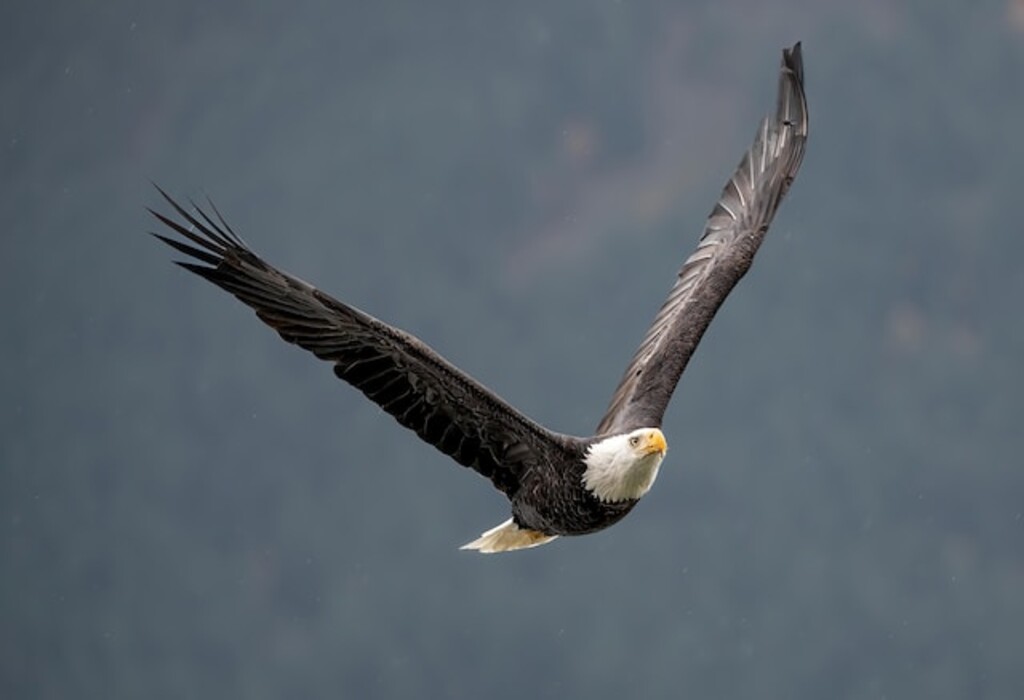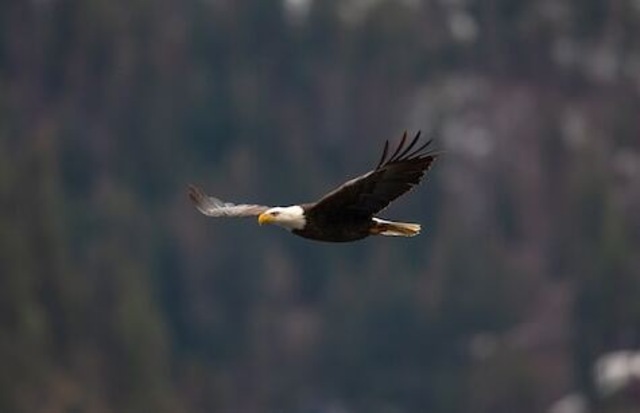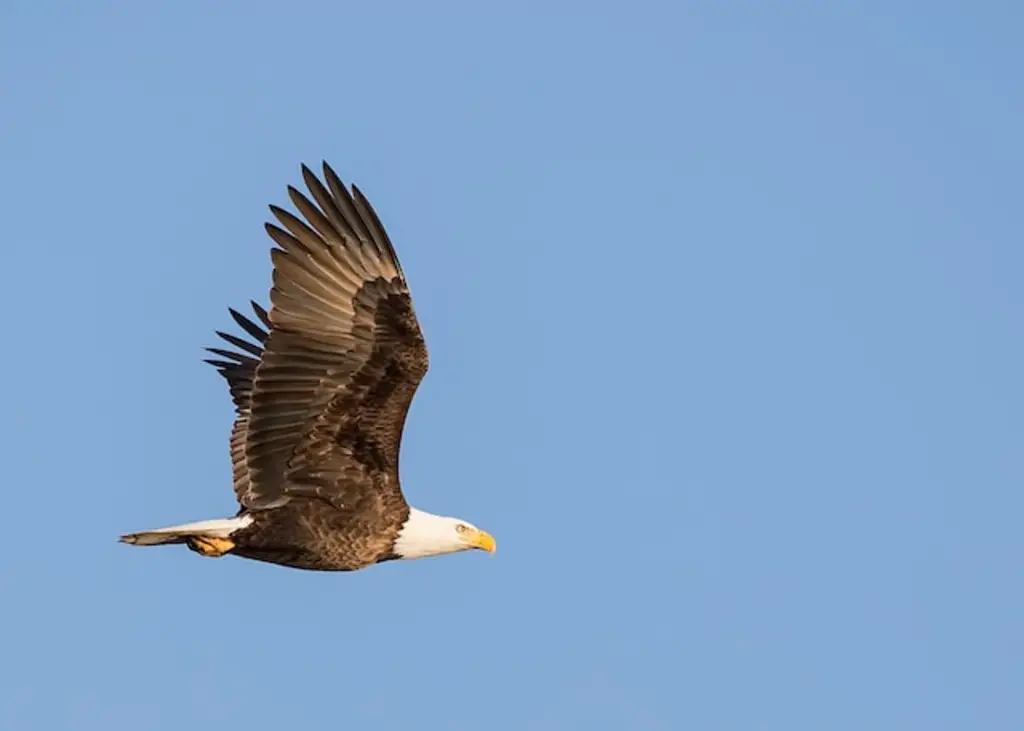Witness the eagle’s awe-inspiring flight abilities as it soars through boundless skies with grace. Discover how long these majestic creatures can fly without landing, propelled by their seven-foot wingspans and unique anatomy.
Learn about their efficient gliding and energy-saving techniques, like riding thermals and updrafts, enabling them to traverse great distances without rest.
Yet, even eagles have limitations. Weather conditions, prey availability, and feeding challenges influence their flight endurance.
Join us on a scientific journey, uncovering the secrets of the eagle’s extraordinary flight. From the longest recorded flights to potential risks, this article illuminates the wondrous world of eagle flight and their unparalleled freedom and resilience.
Table of Contents
- 1 Key Takeaways
- 2 How Long Can An Eagle Fly Without Landing
- 3 Overview of Eagle Flight Abilities
- 4 Anatomy and Physiology of Eagles’ Wings
- 5 Efficient Flight Techniques
- 6 Factors Affecting Flight Endurance
- 7 Longest Recorded Flight Durations
- 8 Migration Patterns and Long-distance Flights
- 9 Energy Conservation Strategies
- 10 Hunting and Feeding in Flight
- 11 Potential Risks and Limitations of Continuous Flight
- 12 Conclusion and Implications for Conservation Efforts
- 13 Frequently Asked Questions
- 13.1 How much food does an eagle need to consume in order to sustain continuous flight?
- 13.2 Can eagles fly at night?
- 13.3 Do different species of eagles have different flight endurance capabilities?
- 13.4 Are there any known health issues that can limit an eagle’s ability to fly for long periods of time?
- 13.5 How do environmental factors such as weather and wind patterns affect an eagle’s flight endurance?
- 14 Conclusion
- 15 Author
Key Takeaways
- Eagles have remarkable flight abilities, allowing them to soar for extended periods without landing.
- Their wingspan can reach up to seven feet, enabling efficient gliding and minimizing energy expenditure.
- Factors like weather conditions, prey availability, and energy conservation strategies affect the duration of their flights.
- Eagles can migrate over long distances, covering thousands of miles in a single journey, to find suitable habitats and resources.

How Long Can An Eagle Fly Without Landing
An eagle can fly for hours without landing, showcasing remarkable endurance. Its efficient gliding, wing design, and mastery of updrafts and thermals enable continuous flight.
However, factors like weather, prey availability, and energy conservation impact flight duration. Despite these limitations, eagles’ remarkable flight abilities demonstrate their resilience and adaptability.
Overview of Eagle Flight Abilities
The flight abilities of eagles are remarkable, allowing them to soar through the air for extended periods of time without the need for frequent landings.
One of the most notable flight adaptations of eagles is their ability to migrate over long distances.
Eagles are known for their impressive migratory patterns, with some species able to cover thousands of miles in a single journey.
This ability to fly long distances without landing is crucial for their survival, as it allows them to find suitable habitats and resources throughout the year.
Additionally, the anatomy and physiology of eagles’ wings play a significant role in their flight capabilities.
Their large wingspan, strong flight muscles, and specialized feathers enable them to maintain lift and maneuverability during flight.
These adaptations allow eagles to soar effortlessly in the skies, making them highly efficient and agile hunters.
Anatomy and Physiology of Eagles’ Wings
One key aspect to consider when examining the anatomy and physiology of eagles’ wings is their remarkable endurance in the air.
Eagle wing structure plays a crucial role in their ability to sustain flight for extended periods without landing.
The wings of eagles are long and broad, providing a large surface area for generating lift. Additionally, the feathers on their wings are designed to reduce drag and increase aerodynamic efficiency.
Flight mechanics of eagles involve a combination of flapping and gliding. They use powerful wing beats to gain altitude and maintain speed, followed by gliding to conserve energy.
This efficient flight technique allows eagles to soar for long distances without tiring.
Transitioning to the subsequent section about efficient flight techniques, eagles have also developed other strategies to maximize their endurance and minimize energy expenditure.
Efficient Flight Techniques
Efficient flight techniques employed by eagles encompass a combination of flapping and gliding, allowing them to effortlessly traverse long distances while minimizing energy expenditure.
Gliding techniques play a crucial role in an eagle’s flight, as they enable the bird to cover great distances with minimal effort.
Eagles have large wingspans and broad wings, which aid in generating lift and maximizing gliding capabilities.
The wing morphology of eagles is specifically adapted for efficient flight, with long and broad wings that provide ample surface area for gliding.
By utilizing thermals and updrafts, eagles can sustain prolonged periods of gliding without flapping their wings.
This technique allows them to conserve energy and maintain flight endurance for extended periods.
Understanding the factors affecting flight endurance in eagles is crucial in determining how long they can fly without landing.

Factors Affecting Flight Endurance
Factors such as wind patterns, thermals, and wing morphology significantly impact the endurance of an eagle’s flight, evoking a sense of awe at the intricate interplay of these elements in enabling the bird to remain airborne for extended periods.
Wind patterns play a crucial role in determining the efficiency and duration of an eagle’s flight. Favorable tailwinds can provide a boost, allowing the bird to cover long distances with less effort.
Thermals, on the other hand, are rising columns of warm air that eagles utilize to gain altitude without expending much energy.
Wing morphology, including its shape and size, also contributes to flight endurance by affecting lift and maneuverability.
These environmental factors, combined with the eagle’s remarkable adaptations, allow it to soar effortlessly for extended periods.
Transitioning into the subsequent section about the ‘longest recorded flight durations,’ it is intriguing to explore how these factors influence the astonishing feats achieved by eagles in the wild.
Longest Recorded Flight Durations
Wind patterns, thermals, and wing morphology have played a crucial role in enabling birds to achieve remarkable flight durations, such as the case of a large raptor effortlessly traversing vast distances over varied terrain with minimal energy expenditure.
When it comes to eagles, their flight endurance has been the subject of interest among researchers and bird enthusiasts alike.
Tracking eagle flight patterns has allowed scientists to gather data on the longest recorded flight durations.
For instance, the satellite tracking of a Steppe Eagle revealed that it covered a distance of 6,000 kilometers within 14 days without landing.
Similarly, a Golden Eagle was recorded flying continuously for over 125 miles in less than two hours.
These remarkable flight records highlight the incredible capabilities of eagles and their ability to sustain flight for extended periods of time.
Transitioning into the subsequent section about migration patterns and long-distance flights, it is evident that eagles are not only capable of enduring long flights but also engage in migratory behaviors.
Migration Patterns and Long-distance Flights
Migration patterns and long-distance flights are phenomena that have captivated scientists and bird enthusiasts due to their intricate nature and the impressive distances covered by various species of birds.
Understanding how birds navigate over long distances and the importance of stopover sites during their journey is crucial in unraveling this remarkable behavior.
Birds employ several strategies for long-distance navigation, including celestial cues, landmarks, magnetic fields, and even olfactory cues.
These mechanisms allow birds to accurately orient themselves and maintain a consistent direction during their migration.
Additionally, birds rely on stopover sites along their migration route to rest, refuel, and replenish their energy reserves.
These sites provide crucial resources such as food and suitable habitats, enabling birds to continue their journey.
Transitioning into the subsequent section on energy conservation strategies, birds employ various tactics to minimize energy expenditure during long flights.

Energy Conservation Strategies
Birds employ various methods to optimize their energy expenditure during extended flights, ensuring their survival and successful completion of their migration journey.
Energy-saving techniques play a crucial role in enabling birds, including eagles, to fly long distances without landing.
Flight mechanics, such as soaring, gliding, and thermal soaring, allow birds to minimize the amount of energy expended during flight.
By utilizing updrafts, air currents, and thermals, birds can gain altitude and maintain their position in the air without flapping their wings excessively.
Additionally, birds adjust their flight speed and altitude to take advantage of tailwinds and minimize headwinds, further conserving energy.
These energy conservation strategies enable eagles to fly for extended periods without landing, sometimes covering thousands of kilometers.
Transitioning into the subsequent section about hunting and feeding in flight, these energy-saving techniques also play a crucial role in supporting the eagles’ ability to catch prey while airborne.
Hunting and Feeding in Flight
Utilizing their keen vision and precise aerial maneuvers, raptors adeptly secure sustenance while in mid-flight, employing their unique hunting and feeding strategies.
These strategies allow them to effectively capture prey and consume it while in flight, minimizing the need for frequent landings.
Here are three key hunting techniques and feeding strategies employed by eagles and other raptors:
- Scanning and targeting: Eagles have exceptional eyesight, enabling them to spot potential prey from great distances. They scan the landscape below, searching for movement or distinctive shapes that indicate potential meals.
- Dive and snatch: Once a suitable target is identified, eagles employ their powerful wings to rapidly descend towards their prey. With precision timing, they extend their talons and snatch the prey mid-flight, often catching it by surprise.
- Tearing and swallowing: Eagles have sharp, curved beaks that allow them to tear apart their prey while in flight. They consume smaller prey whole, but for larger prey, they tear off bite-sized pieces and swallow them.
These hunting and feeding strategies enable eagles to sustain themselves during long flights without the need for frequent landings. However, continuous flight also presents potential risks and limitations, which will be discussed in the subsequent section.
Potential Risks and Limitations of Continuous Flight
Continuous flight presents potential risks and limitations, as raptors must navigate through changing weather conditions and face the challenge of finding suitable resting and roosting spots during their journeys.
These risks and limitations can have significant implications for the survival and conservation of eagle populations.
One of the main risks is the exposure to adverse weather conditions, such as strong winds, heavy rain, or extreme temperatures.
These conditions can impact the eagle’s ability to fly efficiently, potentially leading to exhaustion or even death.
Additionally, the limited availability of suitable resting and roosting spots along their flight path can further exacerbate the challenges faced by eagles during continuous flight.
Consequently, conservation efforts should focus on identifying and preserving key resting and roosting sites, as well as monitoring weather patterns to ensure the safety and well-being of these magnificent birds.
Transitioning into the next section, understanding the risks and limitations of continuous flight is crucial for developing effective conservation strategies.

Conclusion and Implications for Conservation Efforts
The understanding of the risks and limitations of continuous flight has significant implications for the development of effective conservation strategies to ensure the survival and well-being of raptors during their long-distance journeys.
These strategies should take into account the potential environmental impact of continuous flight on the birds and their habitats.
Some key considerations for conservation efforts include:
- Establishing protected areas and flyways: Designating protected areas along the migratory routes can provide safe resting and foraging grounds for raptors during their long flights, reducing the risks of exhaustion and starvation.
- Monitoring and research: Continuous monitoring of raptors’ flight patterns and behaviors can provide valuable insights into their needs and vulnerabilities, helping to inform targeted conservation actions.
- Addressing human-induced threats: Conservation strategies should address the human-induced threats that raptors face during their flights, such as habitat loss, pollution, and collisions with human structures.
- International collaboration: Effective conservation efforts require international collaboration to ensure the protection of raptors across their entire migratory range, recognizing that these birds traverse multiple countries and ecosystems.
By considering these factors and implementing appropriate conservation strategies, we can help safeguard the survival of raptors and their ecosystems during their remarkable long-distance flights.
Frequently Asked Questions
How much food does an eagle need to consume in order to sustain continuous flight?
The eagle’s metabolic rate is remarkably efficient, allowing it to sustain continuous flight for extended periods. Altitude has a significant impact on flight endurance, with higher altitudes requiring increased energy expenditure. The eagle’s diet must provide sufficient calories to fuel this demanding activity.
Can eagles fly at night?
Eagles have excellent night vision and can hunt in the dark. They navigate using their keen eyesight and the stars. Their ability to see in low light conditions allows them to be effective predators even during nighttime.
Do different species of eagles have different flight endurance capabilities?
Flight patterns and evolutionary adaptations vary among different species of eagles, resulting in different flight endurance capabilities. Understanding these differences is crucial for appreciating the freedom and adaptability of these majestic creatures.
Are there any known health issues that can limit an eagle’s ability to fly for long periods of time?
Eagle wing injuries, such as fractures or dislocations, can limit their ability to fly for long periods. Additionally, pollution can affect their respiratory system, compromising their flight endurance.
How do environmental factors such as weather and wind patterns affect an eagle’s flight endurance?
Weather conditions and wind patterns greatly impact an eagle’s flight endurance. Unfavorable weather, such as strong winds or storms, can limit their ability to fly for long periods of time, while favorable conditions can enhance their endurance and freedom in the sky.
Conclusion
In conclusion, the flight abilities of eagles are truly remarkable. Their anatomy and physiology, combined with efficient flight techniques, allow them to soar through the skies for extended periods of time.
Factors such as weather conditions, prey availability, and energy conservation strategies also play a role in their flight endurance.
While the longest recorded flight durations are impressive, it is important to consider the potential risks and limitations of continuous flight.
Understanding these aspects is crucial for effective conservation efforts aimed at protecting these magnificent birds.
As the saying goes, ‘The sky is the limit,’ and for eagles, this rings true as they navigate and conquer the vast expanses of the sky.



